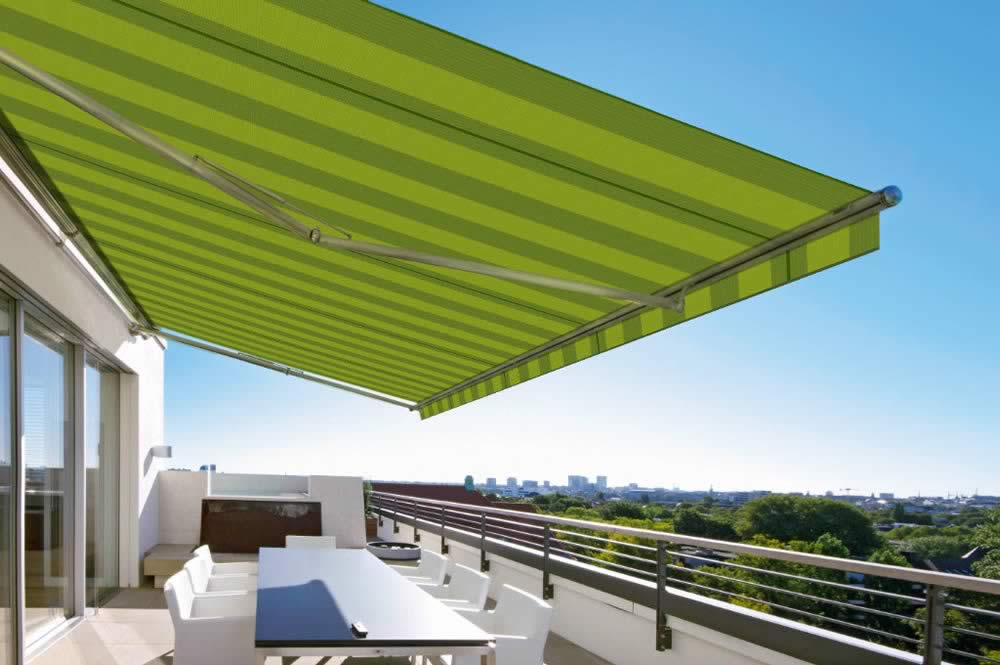Reproofing Canvas:
A canvas awning is waterproof because the fibres swell when wet, however over time it will dry out, and reproofing has the effect of swelling the fibres again, while also adding a water repellent. Reproofing agents can be either petroleum or water based, although I have found that the former tend to last better.
Reproofing Acrylic:
Awnings made of acrylic are waterproof because of chemical treatment, not the swelling of the fibres, and this can loose its effectiveness over time. In my experience, with normal use they tend to last many years without the need to reproof, however when the time comes, since the fluorocarbon used for the original treatment will repel silicone of some reproofing liquids, a floropolymer-based product is best suited to acrylic awnings. Generally petroleum treatments work better than water based ones on acrylic. Once you have chosen the product to use, the application method is as described for canvas.
Reproofing Procedure:
If you have an awning that needs reproofing, first ensure that it is thoroughly clean, and the use of detergent, and light scrubbing is acceptable as you are going to reproof anyway. Ensure that any detergent is fully washed out with copious amounts of clean water, before allowing the material to completely dry.
On a dry day, fit the awning into the caravan awning rail, but do not use the frame at this stage. Instead peg the roof tightly to the ground at a slight angle to the caravan wall, ensuring that it is not in direct contact with the caravan wall, and tuck any spare wall canvas out of the way. Then either paint or spray the roof section with proofing, and leave to dry.
Next erect the awning as normal on the frame, and peg out firmly to ensure all the walls are taught. Now from outside, either spray or brush the proofing onto the canvas, paying particular attention to the seams, and taking care to remove any that runs onto the plastic windows. Spirit based agents will damage plastic windows and plastic zips, so take extreme care. Do not reproof your awning on the lawn at home, as any excess proofing liquid may kill the grass it contacts. Once the awning is fully dry, it can be folded again, however, the longer you can leave it erected, the better, as petroleum based proofing agents in particular have an unpleasant oily aroma that will only dissipate with time.
Storage
Ensure that both canvas and poles are completely dry before packing into the storage bags. Then keep them together in a dry and well-ventilated area. If you have zip out panels, ensure that these are not folded too tightly, as the window sections are easily damaged by indentations from zips, and creasing.
Mould and Mildew
Damp canvas is prone to mould and mildew, so canvas awnings should be dried thoroughly before storing. If you have to dismantle and pack the awning while it is wet, ensure that it is not left in the bag for more than 48 hours before removing to dry completely. This may be by erecting it again, or by hanging it temporarily in the garage, remembering if necessary to turn it regularly until fully dry. Acrylic material is affected less by dampness, but that is no reason to be complacent, so ensure this too is dry before storing.
Leaks
A new awning may initially leak slightly at the joints, so it is a good idea when first put up, to give it a good soaking as this will allow the stitching to swell. Ensure that it is fully dry again before dismantling. It may take several attempts to fully seal all of the joints, but after it has weathered a while, it should be completely waterproof.
Condensation
Don’t confuse a leaking awning, with one that has condensation forming on the inside. Condensation is common in the cooler damp months of spring and autumn, and will often form on the plastic windows, and around the poles when there is a notable difference in temperature between the inside and outside of the awning. Damp grass underfoot, or cooking in the awning can also increase the probability of condensation forming. Unfortunately this is normal, although by ensuring adequate ventilation, this can be reduced. It may be necessary to lift the mud wall slightly to ensure airflow.



















Comments